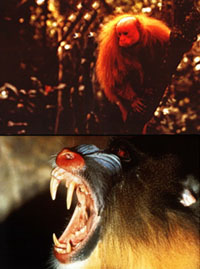The Physical Characteristics of Humans
- Page 13 -
Color Vision
Human beings also share with other primates the ability to perceive color; that is, our eyes are equipped with both rods and cones. Mammal species other than primates lack this ability and perceive the world in shades of gray.
 The ability of primates to see color is probably related to the needs of our remote animal ancestors to distinguish between ripe and unripe fruits in their tree-top habitat. Having color vision also means that they lived active lives in the daylight.
The ability of primates to see color is probably related to the needs of our remote animal ancestors to distinguish between ripe and unripe fruits in their tree-top habitat. Having color vision also means that they lived active lives in the daylight.
The inability of most other mammals to perceive color may indicate their evolution from small, furtive animals that survived through the Age of Dinosaurs by adopting nocturnal modes of life, where color perception would be meaningless. Because primates see color, they are often brightly colored themselves and respond to color as part of their social behavior. The male Ukaris monkey from South America is an extravagant example of coloring. The male Mandrill baboon from central Africa below right has a brightly colored face and a matching rump. Color is often used as a sexual signal among primates to indicate dominance in males and receptivity or estrus in females.
 The ability of primates to see color is probably related to the needs of our remote animal ancestors to distinguish between ripe and unripe fruits in their tree-top habitat. Having color vision also means that they lived active lives in the daylight.
The ability of primates to see color is probably related to the needs of our remote animal ancestors to distinguish between ripe and unripe fruits in their tree-top habitat. Having color vision also means that they lived active lives in the daylight.
